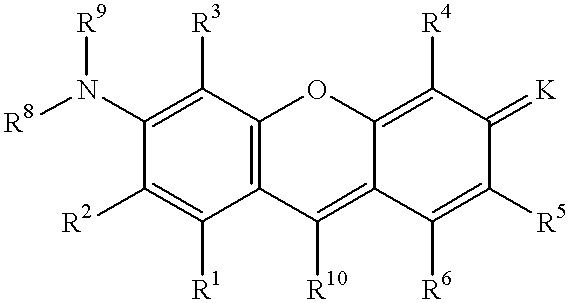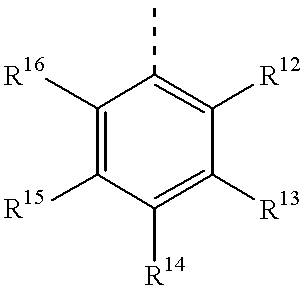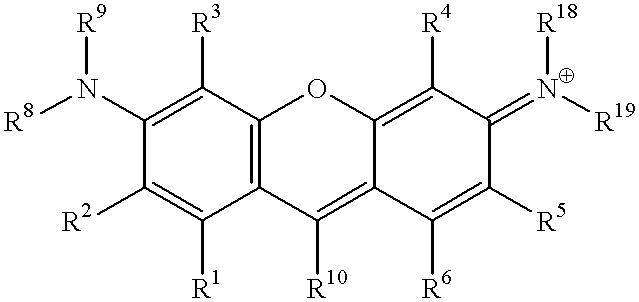Quenching oligonucleotides
- Summary
- Abstract
- Description
- Claims
- Application Information
AI Technical Summary
Benefits of technology
Problems solved by technology
Method used
Image
Examples
example 2
Preparation of chemically reactive quenching moieties (Compound 6)
Compound 1 of Example 1 (2 g) is heated in 20 mL of phosphorous oxychloride at 70.degree. C. for 6 hours. The solution is evaporated under reduced pressure and the residue is dried in vacuo for several hours to yield the sulfonyl chloride derivative (Compound 4). ##STR12##
Isonipecotic acid (20.5 g) is heated at reflux for 30 minutes in 80 mL of hexamethyldisilazane in the presence of a catalytic amount of concentrated sulfuric acid. Excess hexamethyldisilazane is evaporated and the residue is dissolved in 150 mL of acetonitrile and cooled to 0-5.degree. C. Triethylamine (23 mL) is added, followed by 29 g of Compound 2 in 150 mL of acetonitrile to generate Compound 3, which is isolated by evaporation of the solvent, addition of 1 M HCl, extraction into chloroform and evaporation. ##STR13##
To a stirring solution of Compound 5 (2.26 g) in 20 mL of acetonitrile at room temperature are added sequentially 1.1 mL of diisopro...
example 3
Prelaration of a reactive 6uenchin moiety (Compound 8)
To Compound 4 (Example 2, 1.5 g) in 20 mL of methylene chloride is added 0.72 mL of chlorosulfonic acid, followed by 4.5 mL of acetic anhydride. The mixture is stirred at room temperature overnight and 100 mL of ether is added precipitate the crude product. Purification is by chromatography on a silica gel column eluting with 9:1 acetonitrile / wateer to yield 1.0 g of the pure sulfonated derivative Compound 7. ##STR15##
To 0.6 g of Compound 7 in 60 mL of DMF at room temperature is added 0.48 mL of diisopropylethylamine and 0.93 g of 2-succinimido-1,1,3,3-tetramethyluronium tetrafluoroborate. The mixture is stirred for 30 minutes. Ethyl acetate (240 mL) is added. The mixture is stirred overnight and the product Compound 8 is recovered by filtration. ##STR16##
example 4
Prearation of a reactive guenching moiety (Compound 11)
A mixture of 2 g of Compound 2 (Example 1) and 20 mL of phosphorous oxychloride is heated at 65.degree. C. for 6 hours. Excess reagents are removed under vacuum and the residue is dissolved in 50 mL of acetonitrile and cooled to ca. 10.degree. C. To this solution is added 9.2 mL of diisopropylethylamine and 10.8 mL of ethyl isonipecotate. After 2 hours the acetonitrile is removed under vacuum and the reaction is worked up with 1 M HCl and extracted into chloroform. The crude product is purified on a silica gel column to yield 1.88 g of the pure ester Compound 9. ##STR17##
To 0.31 g of Compound 9 in 60 mL of methanol is added 1.5 mL of a 10% NaOH solution and the mixture is heated at 35-40.degree. C. overnight. Another 2 mL of 10% NaOH is introduced and heating is continued for another 20 hours. The reaction mixture is cooled to room temperature, 120 mL of 1 M HCl is added and after another hour the product is filtered to give Com...
PUM
| Property | Measurement | Unit |
|---|---|---|
| Nanoscale particle size | aaaaa | aaaaa |
| Nanoscale particle size | aaaaa | aaaaa |
| Nanoscale particle size | aaaaa | aaaaa |
Abstract
Description
Claims
Application Information
 Login to View More
Login to View More - R&D
- Intellectual Property
- Life Sciences
- Materials
- Tech Scout
- Unparalleled Data Quality
- Higher Quality Content
- 60% Fewer Hallucinations
Browse by: Latest US Patents, China's latest patents, Technical Efficacy Thesaurus, Application Domain, Technology Topic, Popular Technical Reports.
© 2025 PatSnap. All rights reserved.Legal|Privacy policy|Modern Slavery Act Transparency Statement|Sitemap|About US| Contact US: help@patsnap.com



